Menus
- The Z ReviZitee
- Introduction
- Discovery
- In the saddle
- In the city
- Departmental
- National
- Highway
- Braking
- Practical aspects
- Conclusion
- Box: Discussion with the Kawasaki staff: and meanwhile, the Japanese are laughing
- LR: The curves of the motorcycle evoke a snake ready to pounce. You thought about it while drawing it?
- LR: Exactly the design is omnipresent, the smallest part is designed specifically for this model: mirrors, plates you even changed the foundry of the cylinders, it must have been very expensive.!?
- LR This model has a strong personality, in another style, your approach is reminiscent of Ducati, which makes motorcycles strong in character.
- LR: By the way, LEDs consume less than traditional headlights, you have reduced the power of the alternator?
The Z ReviZitee
From the top of its eleven Z’an, the Z rolls mechanics and adopts a new look "which is scary". For this new model, the manufacturer endorses the concept of " Sugomi ", A Japanese term which designates:" An astonishing, imposing aura, a terrifying presence ". But beyond the look, KawaZaki has also made some updates….

Introduction
Appeared in 2003, the Z 1000 is the modern heir to the famous 1972 Z 900, itself designed to dethrone the Honda CB 750 which arrived 3 years earlier. From its very glorious ancestor, the Z 1000 kept the 4 pots … and not much else. Four flutes which immediately gave it a particular style, very recognizable, but whose low volume made the engine particularly hollow. Redesigned in 2007, the Z takes the trunk, but it is especially the 2010 vintage which marks a big progress. On the one hand, it abandons the 953 cm3 engine derived from the ZX 9 R in favor of a 1043 from the Z X 10 R. From 127 hp at the start, the power goes to 138, with much more torque. Character wins.
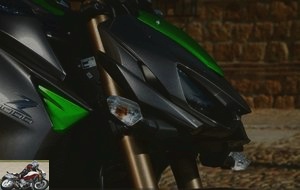
On the other hand, to cope with this development and also to save weight, the Z 2010 receives an aluminum frame, also inspired by the ZX 10R. Result 15 kg less and more rigorous behavior. Like 2007, 2014 is not a total overhaul of the concept (albeit visually), but more of a solid upgrade of a model in the prime of its life..
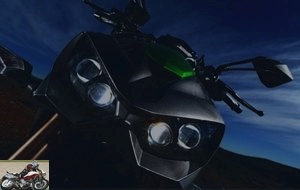
Discovery
At first glance we see that the beast has not let go over the years. She spent more time in the weight rooms than sitting on her couch behind her TV, beer in hand. The lines are tense, the muscle is protruding and the eyes are particularly sharp. The four Led lights, almost at the level of the lower tee, have a feline side ready to pounce. The tiny cockpit that protects the dashboard, with its built-in nightlight, gives it the look of an inconvenient predator, almost an Alien. It will break loose !
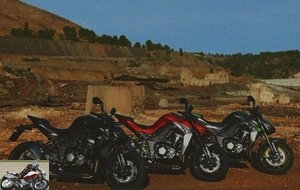
It’s very manly, but the exterior foundries of the engine have advantageously abandoned their manga side for a sobriety of good quality. Since we are talking about the engine, note that its reworked intake (new camshaft, 4 long intake pipes, instead of 2 long and 2 short, new mapping, new airbox and c) should improve the availability to mid-range. The work of ventilation of the housings (blow-by) combined with all of these developments allows to gain 4 hp and torque at low speed. 142 hp, like the new Z 1000 SX its twin and twin throttle bodies placed closer to the valves to improve engine response. The upper, oval throttle is managed by the computer, the lower one is controlled by the pilot. Here, however, no traction control or other driving modes. We keep the manly side, without sanitizing it.
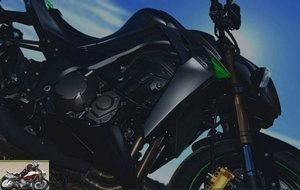
After this little tour of the owner, let’s take a.
In the saddle
The tapered aluminum handlebars are wide and almost straight. To reach it you have to tilt your chest a little forward. We immediately feel that the piloting of this machine will essentially be played around the front axle. The width of the saddle is reasonable at the level of the tank. Thank you for the oval butterfly housings and placed lower, we were even able to put two liters of gasoline without it noticing. Good game! Those under 1.70 m don’t have to put their feet on the ground. In fact the bike seems small for a 1000. The new dashboard, inspired by the ZX 10 R, displays the speed in bargraph, above 4000 rpm. Below, the LCD screen takes care of it. Among the information available, we note the presence of an econometer. It is well seen.
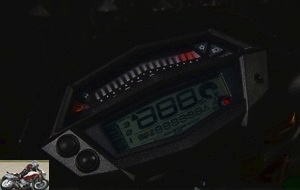
After all, a roadster can also be used on a daily basis, even if you buy it first to work on it. To turn on the eco mode, you need three conditions: stay below 6000 rpm and 140 km / h and have less than 30% throttle opening. For the rest, we have a gauge, a watch and the usual indications. No gear indicator on the other hand, but an on-board computer which indicates the average and instantaneous consumption as well as the residual autonomy…. based on instantaneous consumption (blah). Too bad that this information is not available from the handlebars, you have to let go of your left hand to activate a button directly on the dashboard to scroll through them.
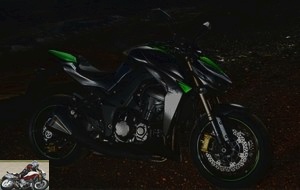
In the city
Here the 4-legged flaunts its incredible flexibility. No need to spin the clutch to take off at a red light. We move smoothly without knocking or hiccups. The sixth is even able to resume in slow motion! No stress. The very low power available makes it possible to jump at a red light. The pounds are not felt, as the machine is well balanced. We move easily, not having the impression of riding a big motorcycle. The only downsides to the table, the turning radius, which is a little too large, penalizes maneuvering. Mention well all the same, the daily life will have nothing scary in the Z’embaras.
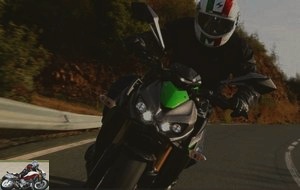
Departmental
If the small and medium displacement are bland in multicylinders, with 1043 cm3, it is something else. Thanks to the proximity between the valves and the throttle bodies, the response to the grip is very keen. More than the old version. While you don’t get a real kick in the butt with every twist of the grip, the stables are still very well populated from low revs. There is horse in this Kawa and once is not customary, the manufacturer will not be ashamed to include it on the label. On the contrary, he boasts of having worked for! The availability of this mechanism and its range of use are incredible, so much so that if you want to ride "cool", you can keep the sixth gear all the time, without dragging yourself a bit. In fact, we often look for a seventh as the pickups are surprisingly lively, regardless of the speed..
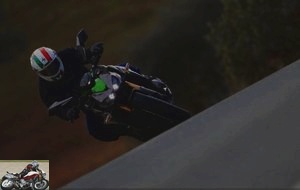
The sound of the admission has been designed to be both fuller and more virile at mid-speed. It reinforces the impression of power and availability. As a real Kawa engine, the Z rushes towards the red zone (11,000 rpm). The thrust is then strong and constant, almost linear, but really powerful. The melody of happiness accompanies these flights when we are in the towers. A very successful engine therefore, in a chassis that is no less. The very lively geometry of the front axle allows the bike to be easily placed in bends. The entry speeds into bends are high, even if at the beginning we remain a little on our guard, on an unknown road, in view of the inertia specific to a machine of this displacement (gyroscopic effect of the engine) and of this weight. . The pounds are not felt, but they are there and should be taken into account in his ability to improvise. Then as the kilometers go by, we get emboldened because the Z never holds any bad surprises. Everything is under control, especially as the excellent overall ergonomics facilitate the rider’s movements, which leaves some reserve when a turn is closed. Let’s see what happens going faster.
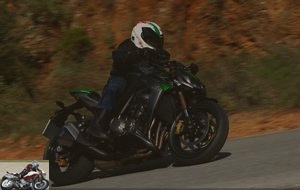
National
The extreme liveliness of the nose gear could give some concerns about the stability at high speed. In fact, it is not. When the speed and radius of the curves increase, the Z reveals another facet of its personality and inspires complete confidence in its rider. Nothing breaks up, nothing moves. The big curves are swallowed at speeds worthy of a sports car. It must be said that the robust chassis that inspires confidence visually is perfectly up to the situation. Derived from the ZX 10 R, it cashed without flinching the 142 rabid horses. Returning twenty horses to the S 1000 R, 28 to the Aprilia and even 38 to the KTM 1290, the Kawa is not however left in question of power..
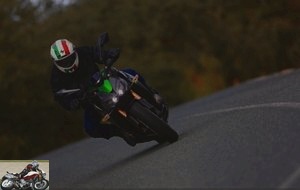
Seen like this, we even wonder if it is not the others who are in excess. There are clearly enough of them !
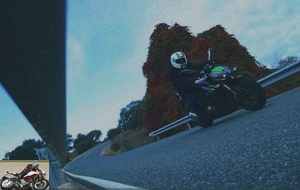
Highway
This is certainly not the vocation of such a machine. As you would expect, the high speed protection is nil. The short gear (43/15 against 41/15 on the SX) but the extended 6th, still leaves incredible recoveries at 130. Due to lack of space we only made a small peak at 232 km / h , the time of a flash, (not a flash, eh….) then cut the throttle while it was still accelerating hard. When you are told that 142 horsepower is enough!
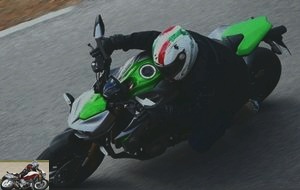
Braking
Modified this year, it is in progress compared to 2010 but also compared to the Z 1000 SX. This is thanks to the adoption of Tokico monobloc calipers, but also a new radial master cylinder with a larger diameter (17.5 to 19 mm) with a modified lever for a better feeling. Last but not least, there are 310 mm petal discs (300 until then and 300 still on the ZX). The feeling is perfect, you can brake very easily with 2 fingers in all circumstances. Kawasaki even claims one-finger braking, but this attitude wasn’t very natural to me, so I didn’t test it. A ride with the ABS version versus the non-ABS version shows control that gently gains what it loses with biting. Designed by Bosh, the ABS itself does not seem at all disturbing or intrusive. We highly recommend it, although you will be charged an additional € 600. It’s a good investment in the future, in every sense of the word.
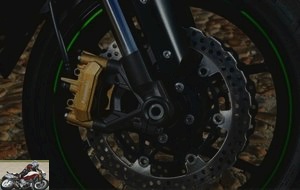
Practical aspects
Let’s start with the Price: € 11,999. IT has not changed from the previous model. It’s good news. A radical roadster, the Z does not force its talent to be practical on a daily basis. It doesn’t make the effort to offer an AR suspension preload adjuster like its sister the SX. No traction control either and even fewer driving modes to choose from. Pure sport, nothing more. Without being part of the hypersophistication, a "cool" mode would have been nice when you want to ride relaxed. But it is also the price of a stiff price. Note, however, the increased capacity of the tank which allows space for refueling. On our haul, at a breakneck pace, the on-board computer indicated 6.5 L / 100 in the morning and 7.2 L in the afternoon. Figures that are in no way representative of normal use where we will consume much less.
Let’s talk a bit about comfort, although it’s not essential on this type of machine. The saddle and the riding position are really excellent. The sporty suspension setting is a little stiff, but you can always adopt softer settings on a daily basis..
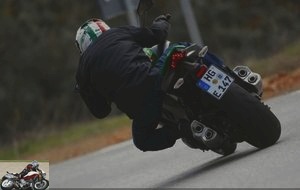
In terms of options, note that the partnerships developed with Rizoma and Akrapovic have enabled the manufacturer to offer accessorization from the release of the model. You can therefore already go and dig into the catalogs of these 2 reputable suppliers to personalize your motorcycles.
Conclusion
A mechanical present, a mouth of predator, a very rigorous chassis, the Z is faithful to itself and to its family. A real Kawa. Compared to its predecessor, it progresses significantly in braking and motor character. However, it does not go into excess, avoiding the race for absolute power, with the control electronics it imposes. Choices that allow it to keep the price unchanged, without cutting back on the pleasure of piloting. The arms race pays off! In short, Ze am very happy with this Z.
Strong points
- Character motorcycle
- Smooth and very full motor
- Healthy and very efficient chassis
- Biting and dosable braking
- Unchanged rate
- Pleasant ergonomics
Weak points
- No gear indicator engaged
- Comfort of sporty suspensions
- Short gear
Datasheet
Box: Discussion with the Kawasaki staff: and meanwhile, the Japanese are laughing
LR: The curves of the motorcycle evoke a snake ready to pounce. You thought about it while drawing it?
Kawasaki: Frankly no, we find him more like a feline (Editor’s note by the way in the presentation video we see a black panther). It is thanks to the small size of the led lights that we were able to make such a low and aggressive front. This is a very expensive choice for us (look at the price of an optional LED headlights in cars!), But for us it was a staple of the personality of this model..
LR: Exactly the design is omnipresent, the smallest part is designed specifically for this model: mirrors, plates you even changed the foundry of the cylinders, it must have been very expensive.!?
Response from the project manager to the designer: “yes it cost us a lot! This model has an interest in selling well, otherwise…. (He pretended to slit his throat, laughing). No seriously he has already designed the Z 800 and the new SX and we are very happy with him.
LR This model has a strong personality, in another style, your approach is reminiscent of Ducati, which makes motorcycles strong in character.
K: Yes, we don’t just want to be a Japanese manufacturer, we want to be Kawasaki!
(Indeed, the presentation took place in a very relaxed atmosphere for Japanese people, with a lot of humor and we guessed that all the speakers had enjoyed themselves by creating this model)
LR: By the way, LEDs consume less than traditional headlights, you have reduced the power of the alternator?
K: Yes, in low beam the bulbs make 13 W instead of 55, but we kept the same alternator as in 2010. Moreover, the life of the bulbs should be that of the motorcycle, which is good. for the user.
Related articles
-
998 cm3, 210 hp at 13,000 rpm, 11.3 m / kg, 300 km / h, 206 kilos, € 17,799 Breathtaking performance, cutting-edge electronics, pure feel… You may not…
-
Kawasaki ZX10R motorcycle test
The motorcycle division of the giant Kawasaki industry, is only a drop in the sea, but that does not prevent it from being a major player in the world of…
-
Ninja Apprentice On paper, we imagine that the Kawasaki Ninja 250 R, with only 33 horsepower, will only appeal to the young drivers. After a week of…
-
4 cylinders in line, compressor, 998 cm3, 210 hp at 11,000 rpm, 137.3 Nm at 9,500 rpm, 260 kilos, € 21,999 Kawasaki reinvents the super-fast and…
-
The balance Euro5 parallel twin, 649 cm3, 68 hp and 64 Nm, 188 kg full made, A2 compatible In life and in its evolution, the Kawasaki Z650 follows in the…
-
Kawasaki Versys 1000 motorcycle test
La Z goes green Eternal absent from the Kawasaki range, apart from the unlikely KLV 1000 (Suzuki V-Str m renamed), the maxi-trail model finally appears…
-
Kawasaki Versys 1000 S Grand tourer motorcycle test
Daily test for fifteen days 1,043 cm3, 120 hp at 9,000 rpm, 102 Nm at 7,500 rpm, 257 kg, 15,099 euros (17,099 euros Grand Tourer version) This bike, to…
-
Kawasaki Ninja ZX-10R KRT motorcycle test
An integer character 4 cylinders in line, 998 cm3, 203 hp, 114.9 Nm, 206 kg all full facts, 18,099 euros. Nice surprise for me to find the Kawasaki…
-
Kawasaki Ninja 1000 SX motorcycle test
Compromise without compromise 4 cylinders of 1,043 cm3, 142 hp and 111 Nm, 235 kg, from 14,349 euros In 2010, Kawasaki presented its first Z1000SX, a…
-
Kawasaki ER-6 N motorcycle test
A very stylish and punchy little urban The city of Mozart sounded for three days of a superb symphony in major exhaust. Orchestrated by Kawasaki making…
So…
Questions about manufacturing quality in China.
Ditto on possible problems of the first series as on other brands.
Motor without sensation with flat encephalogram.
So, apart from the BM coat of arms on the bike, there is nothing left to justify the price?
The reputation for reliability? Well precisely, these last years in motorbike…
No, there, I do not see what added value BM brings compared to its competitors.
Comfort perhaps?
> Godzilla
the twin is not pleasant in its mechanical operation; It’s like listening to a piece of Bach (or other) played by a beginner or a virtuoso. Or play on an electronic organ or on a Steinway…
Between a twin Ducati 797, that of an Aprilia 900 Shiver and the F900R … well the latter does not appeal.
It is a question of interpretation of the same score. And mechanical refinement.
it works efficiently.
What is “left” in BMW? Technology, no doubt. As for other.
Too bad that such a motorist does not manage all his mechanics.
Note, even the S1000RR shiftcame left me with that same feeling of super efficiency without soul.
Agree with you Waboo. To have had and still have twins the vertical twin BM (F850) does not ignite me, those of the KTM 790 and Ducati (for me the Scrambler) even with 100cm3 less are much more generous in sensation. of the SV more character.
I can’t wait to try the 890 Duke R.
I do not know that of the Shiver but I hear only good with an unbeatable value for money since the price reduction applied by Aprilia.
Waboo> Exactly what technology?
No telelever, the engine has an archi architecture used for ages. I don’t see anything that can stand out from the rest.
Electronics maybe? We are close to the gadget.
KTM, Aprilia, Yamaha have at least sensational engines, it can be seller.
These BM vertical twins, I can’t find anything to distinguish them.
The picture maybe.
If Honda releases a small Africa Twin, it will be worse.
> Godzilla
by techno I meant quality electronic assistance. Moreover, I recommend them in the trial, in the pack currently offered, or even after even if + 500 €.
And their TFT screen is top notch. (must admit, and yet, I do not like screens galore …)
In short, I would have preferred neat finishes and mechanical charm to galloping technology.